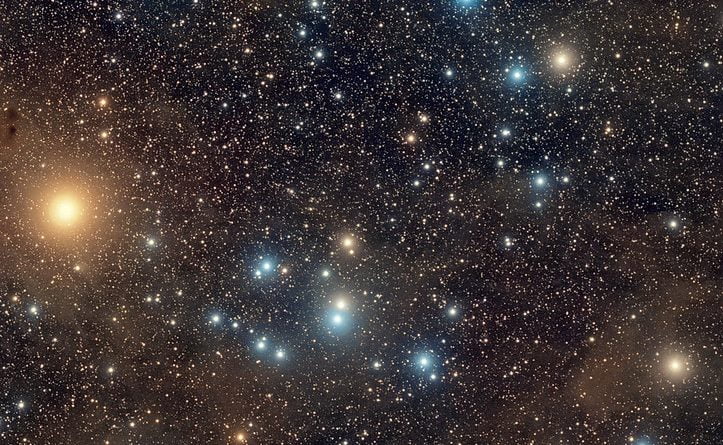The Sky This Week from November 26 to December 3
[ad_1]
Monday, November 29
The early-morning hours between midnight and sunrise are the best time to observe Comet 67P/Churyumov-Gerasimenko as it skims through Cancer the Crab. Currently about 9th magnitude, this periodic comet is less than 7.5° north of the center of the Beehive Cluster (M44) tonight. Recent observations have reported a coma diameter of about 5′.
M44 is a scattered open cluster visible to the naked eye at magnitude 3.7, spanning about 1.5°. Also called Praesepe, or the Manger, ancient Greeks and Romans saw it as the outline of this namesake structure in the sky. It contains about 350 stars between 500 and 600 light-years away, all of which are roughly 730 million years old. Researchers think that this cluster and the Hyades in Taurus may have the same origin, despite their disparate locations today.
Sunrise: 7:01 A.M.
Sunset: 4:36 P.M.
Moonrise: 1:15 A.M.
Moonset: 1:59 P.M.
Moon Phase: Waning crescent (27%)
Tuesday, November 30
Venus, Saturn, and Jupiter are still lined up nicely in the evening sky, visible for at least two hours after the Sun disappears. It’s hard to miss them — particularly Venus, which is blazing a bright magnitude –4.9 amid the stars of Sagittarius the Archer. Just over 18° to Venus’ east is Saturn, a much dimmer magnitude 0.6 against the backdrop of Capricornus. And simply look 16.5° east of Saturn to spot Jupiter, shining at magnitude –2.3. It now sits slightly more than 2° northeast of the star Deneb Algedi.
Venus is the first to set, so let’s focus on it first as well. Its disk currently spans some 39″ and is a little less than 30 percent lit. We see Venus go through phases — just like the Moon — because it is closer to the Sun than Earth. The surface itself is shrouded in a thick atmosphere of toxic gases, so images through a telescope typically show little detail from these cloud tops.
Saturn, which appears 16″ across, is flanked by its magnificent ring system, stretching 35″ across. Titan, the largest and brightest of its moons, is often apparent in binoculars or a telescope. It sits about 52″ south of the planet tonight.
Jupiter appears 38″ across and, depending on when you pick it up in the darkening sky, may be undergoing a transit as the icy moon Ganymede crosses its face. The transit starts before dark in the eastern US and continues until just before 8:30 P.M. EST, when the planet is still well above the horizon. Ganymede’s large shadow slips onto the disk just after 10 P.M. EST and takes more than three hours to cross it.
Once it exits the disk to the planet’s west, Ganymede joins Io (next in line from the planet) and Europa and Callisto. Once again, timing is everything — around 7:44 P.M. EST, Europa appears 7.5″ south of Callisto as it “overtakes” the more distant moon, moving from east to west. So, before this time, Europa appears closer to Jupiter than Callisto. Afterward, it is the last moon out in the line of four.
Sunrise: 7:02 A.M.
Sunset: 4:35 P.M.
Moonrise: 2:24 A.M.
Moonset: 2:25 P.M.
Moon Phase: Waning crescent (18%)
Wednesday, December 1
Planet Neptune is stationary against the background stars at 5 P.M. EST. Floating in Aquarius the Water-bearer, you’ll find the solar system’s most distant planet already 40° high an hour after sunset. You’ll need binoculars or a small scope to spot the magnitude 7.7 planet, which spans a mere 2″ on the sky. Neptune’s diminutive size is due to its distance, as it currently sits roughly 2.8 billion miles (4.5 billion kilometers) from Earth.
To locate the planet, first find 4th-magnitude Phi (φ) Aquarii, then look 3° east-northeast for a small, “flat” star that glows a dull gray-blue. That’s Neptune. During November, the planet was moving southwest, inching closer to Phi. Now, it will reverse course, sliding northeast and slowly increasing its distance from the star.
Sunrise: 7:03 A.M.
Sunset: 4:35 P.M.
Moonrise: 3:37 A.M.
Moonset: 2:53 P.M.
Moon Phase: Waning crescent (10%)
Thursday December 2
This morning, step outside just before sunrise to catch sight of Mars and the thin crescent Moon about 6° apart. Our Moon is a barely illuminated 5 percent lit, while Mars glows a soft magnitude 1.6. The Red Planet currently spans 4″ on the sky and sits in Libra. If you catch the pair about an hour before sunrise, when the brighter stars are still visible, you’ll see that our satellite sits close to magnitude 2.8 Zubenelgenubi, the constellation’s alpha star. Mars lies within 2.5° of 4th-magnitude Iota (ι) Librae, and is 8.8° due south of Zubenesch, Libra’s magnitude 2.6 beta star.
Later today, while both are below the horizon, the Moon passes 0.7° north of Mars at 7 P.M. EST. By tomorrow morning, it will be just over 8° east of Mars, having crossed the border into Scorpius and nearing the Sun.
Sunrise: 7:04 A.M.
Sunset: 4:35 P.M.
Moonrise: 4:53 A.M.
Moonset: 3:27 P.M.
Moon Phase: Waning crescent (4%)
[ad_2]
Original Post


515 thoughts on “The Sky This Week from November 26 to December 3”